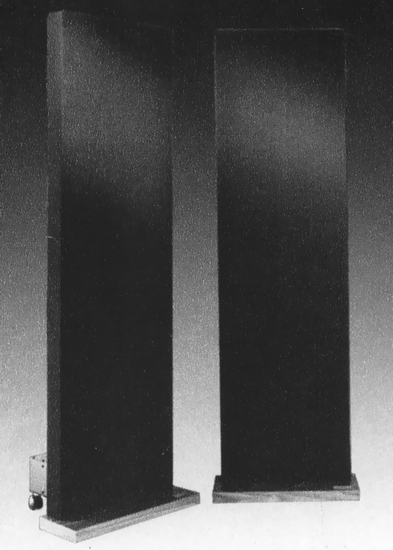
ACOUSTAT Model2M
Price unknown (around 1980 s?)
Commentary
This capacitor-type speaker system was developed by taking advantage of the policy and know-how obtained with the Model2 + 2.
Acorstat speakers are composed of 2 to 6 basic units of 23cmx115cm, and the number of the model number indicates the number of units.
The Model2M is recommended to be used in a room of 4.5 to 8 tatami mats.
Conventional condenser speakers have a 2-way or 3-way configuration that combines a small unit for high-range or mid-range playback with a large unit for low-range playback, which requires the use of a crossover network, which results in poor sound quality.
James C. Strickland of Acorstat Co. discovered that the reason why condenser type speakers cannot reproduce the full band is due to the step-up transformer inside the interface between the power amplifier and the unit. The step-up transformer used in this circuit has a winding ratio of approximately 10 : 1 because the secondary side of the step-up transformer is 1000 V or more. Moreover, since the voltage is high, it must be insulated well. If the insulation is thick, a capacitance is created between the lines the high-frequency characteristics deteriorate. In order to solve this problem, Acorstat realizes the wide-band characteristics by combining two types of transformer, one that emphasizes low-frequency characteristics and the other that emphasizes high-frequency characteristics.
The basic unit consists of a diaphragm sandwiched between two fixed poles, which are connected to the positive and negative outputs of the MK121A interface so that the audio signal from the amplifier, boosted to a higher voltage by the MK121A, can be added.
The diaphragm is charged with a high-voltage, low-current bias voltage, and the two fixed poles on either side create an electric field that is strong enough to match the voltage of the applied audio signal. When the audio signal is applied, the electric field exerts a force on the charged diaphragm, causing the diaphragm to move.
The diaphragm is coated with a thin film of 0.0165 mm by spraying an adhesive dissolved with fine powder of a good conducting material (unpublished material such as graphite).
The fixed electrode is made of PVC-coated copper wires stretched like a grid. The fixed electrode is designed to be as close to the diaphragm as possible, to prevent sparks and damage to the diaphragm, and to minimize interference with sound pressure generated by the diaphragm.
There is an interface MK121A on the lower back of the speakers.
This section consists of two step-up transformers for high and low frequencies and a transformer for supplying bias voltage to the diaphragm.
The booster transformer boosts the output of the power amplifier to a high voltage of approximately 1,500 v. After boosting each of the receiving bands, it is added again to realize the characteristic over a wide band. This output is also input to the fixed pole.
In the transformer for supplying bias voltage, AC100V is boosted to about 1,500 V, which is rectified and input to the diaphragm.
It also has a level control for the high-frequency range.
This MK121A can control up to four basic units by itself, and Model6 requires two units.
The RUNNET is available in off-white as well as normal black.
It seems that the delivery date of off-white is about 3 months when I ordered it.
2 casters are attached to increase the freedom of installation.
Model Rating
| Method | 1-way, 2-speaker floor type |
| Units Used | For full band : 2 x 23cmx115cm electrostatic |
| Frequency characteristic | 35 Hz to 20 kHz ± 2 dB |
| Output sound pressure level | 85dB/W/m |
| Impedance | 4 Ω |
| Level control | Variable level of 10 kHz or |
| Recommended power amplifier output | 100W or More |
| Pwer | 100 VAC, 50Hz/60Hz |
| Power consumption | 5W |
| External dimensions | Body : Width 510x Height 1,820x Depth 89 mm Base Part : Width 560x Depth 480 mm |
| Weight | 30.2kg |
| Attachment | 2 Casters |
.jpg)
.jpg)
.jpg)